Looking to take your lower chest workout to the next level? Look no further than the decline cable fly.
The Cable decline PEC Fly is one of the best exercises for targeting the often lower pectoralis major.
You should add this exercise to your chest training regimen to build more thickness, muscle, and strength in your pecs.
In this blog, we’ll blog we will discuss the following topics:
- What is decline cable chest fly,
- Benefits of doing it
- Muscle worked
- How to do it, and pro-tips.
- Common mistakes to be avoided.
So grab your cables and get ready to pump up your pecs.
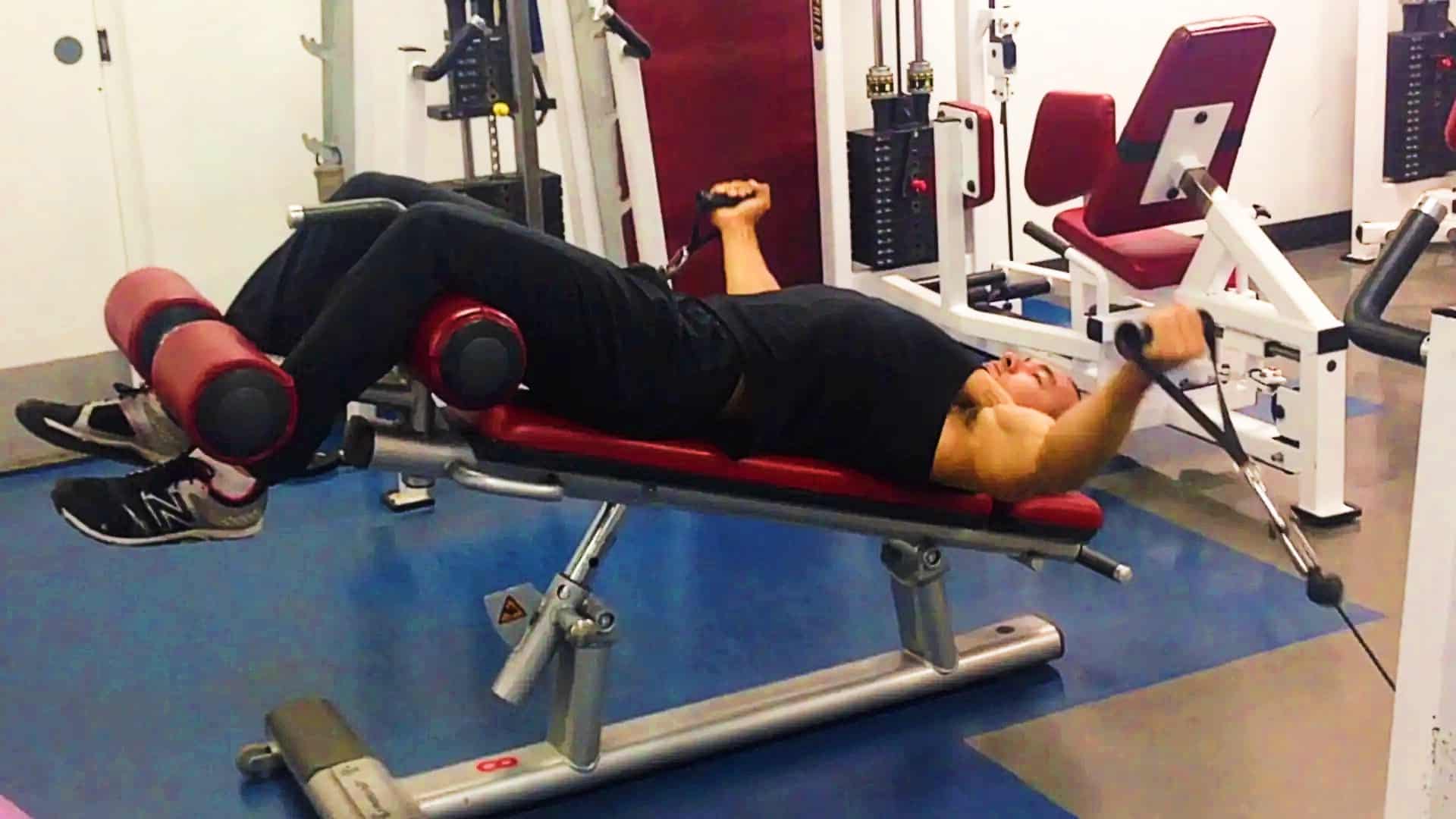
What Is Decline Cable Chest Fly
The decline cable fly is an isolation exercise that primarily targets the lower chest muscles.
The exercise involves using a cable machine, with handles attached at the bottom, while lying on a decline bench.
Unlike dumbbell fly exercises, cable machines provide constant tension throughout the exercise. This keeps your chest muscles active, which makes them work harder.
It is considered to be the perfect finishing move and a great way to focus on your chest after big compound lifts like the bench press and dumbbell press.
Decline Cable Fly Variations
Some popular variations include the standing decline cable fly and the one-arm decline cable fly.
You can also try a decline fly with a pause, holding the weights at the bottom of the movement for a few seconds before bringing them back up.
Experiment with different variations to keep your workouts challenging and effective, and to find out what works best for you.
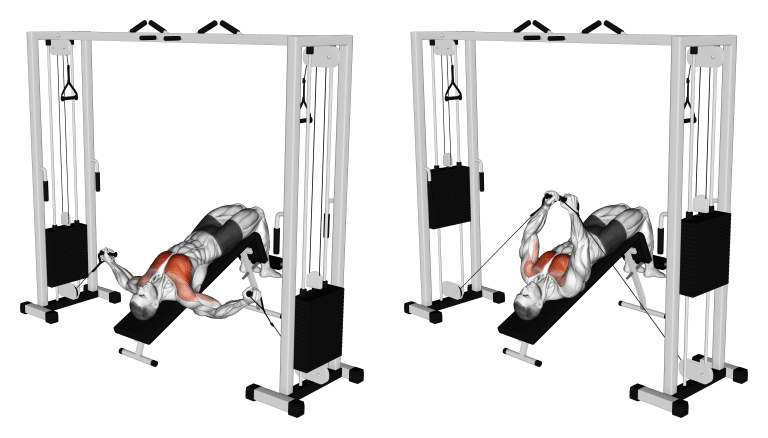
Decline Cable Fly Muscle Worked
The decline cable flys primarily muscle worked are lower pectoralis major muscles.
In addition to its target, the major pec muscle. The decline cable fly has the involvement of several synergist muscles, these muscles include:
- Rhomboids,
- levator scapulae,
- Anterior deltoids, and
- Latissimus dorsi.
A handful of other muscles worked or play the role of stabilizer muscles, including your
- Biceps brachii,
- Brachialis,
- Wrist flexors,
- Obliques, and
- Rectus abdominis.
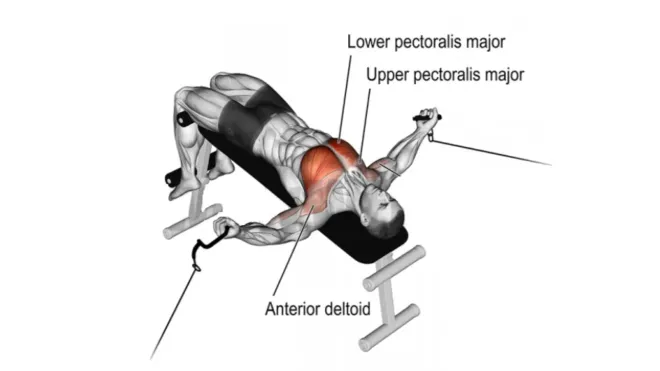
How To Do Decline Cable Fly
- Set a decline bench at a moderate angle (around 15-30 degrees is a good starting point).
- Lie on the bench with your feet flat on the foot pad or the roller.
- Grasp a cable handle in each hand with a neutral grip (palms facing each other).
- Lift your arms straight up from your shoulders and hold the cable handle directly over your chest.
- Slowly lower your arms to your sides until your wrists reach about shoulder level or slightly above.
- Exhale as you reverse the motion, using your chest muscles to bring the handles back to the starting position.
- Squeeze your pecs together at the top of the movement.
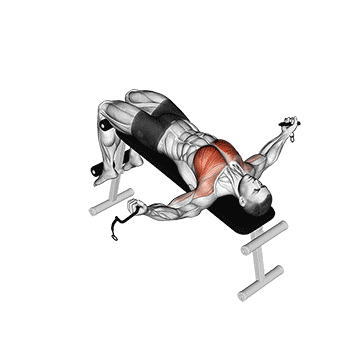
Know More: 14 Best Cable Chest Exercises And Workout Routine
Standing Decline Cable Fly
The standing decline cable fly is a variation of the traditional decline cable fly. Instead of performing the exercise seated on a decline bench, you execute it while standing.
The Standing Decline Cable Fly is also known as high to low cable fly.
It is a machine exercise that primarily targets the lower chest and, to a lesser degree, also targets the shoulders and triceps.

How To Do It
- Set both pulleys as high as possible and choose the desired weight.
- Stand between the cable pulleys with your feet shoulder-width apart.
- Grasp a cable handle in each hand with a neutral grip (palms facing each other)
- Slightly lean forward and extend your arms upward at an angle, with a slight bend in your elbows.
- Pull your hands toward each other (high to low) in wide arcs in front of you.
- Slowly lower back to the starting position.
- Do 8-12 reps per set
One Arm Decline Cable Fly
The one-arm decline cable fly is a unilateral variation of the decline cable fly, that targets one side of the chest at a time.
It is a challenging exercise that requires focus, balance, and stability.
You may be able to bring the handle slightly further across your body compared to the two-arm version, further targeting the inner portion of your chest.
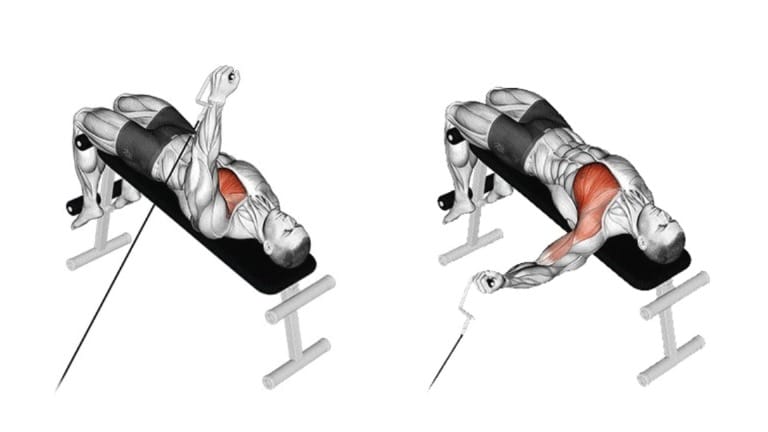
How To Do It
- Adjust the cable machine to the lowest setting and attach a single handle to the cable.
- Lie on a decline bench with your feet secure at the bottom of the bench.
- Grab the handle with one hand and extend your arm straight up above your chest.
- Keeping your arm straight, slowly lower the handle out to the side.
- Pause for a moment at the bottom of the movement.
- Then, slowly bring the handle back to the starting position.
- Repeat for the desired number of repetitions,
- Then, switch sides and repeat the exercise with your other arm.
Form and Pro-Tips
- Set the bench at about a 15–30 degree decline.
- Maintain a slight bend in your elbows throughout the entire movement.
- Focus on a smooth, controlled arc as you bring the cables down and in.
- Emphasize the deep stretch in the bottom position.
- Pretend you’re hugging a large tree as you bring the handles together. Squeeze the chest muscles together at the top of the movement.
- Vary the position of the bench to hit different angles of the lower chest.
- Don’t let your elbows drop too far when you’re in the start position, they should remain in line with your torso.
- Pick a weight that you can control, that’s not too light or too heavy — find what’s right for you.
- Inhale as you lower the weight and exhale as you lift it.
Best Alternate of Decline Cable Fly
Best alternative exercises that target the same primary muscle groups with different equipment.
Here are some alternative exercises that can effectively target the lower chest muscles as a replacement for decline cable fly:
- Decline dumbbell bench press
- Cable Decline Bench Press
- Decline dumbbell fly
- Incline push ups
- Chest dips
FAQs
What muscles does the decline cable fly work?
The decline cable fly primarily targets the lower chest muscles, but also works the shoulders and triceps to a lesser extent.
How many sets and reps should I do for decline cable fly?
Beginners should do 3–4 sets of 8–12 reps with a moderate weight.
Can the decline cable fly replace other chest exercises like bench press?
The decline cable fly is a useful addition to your chest workout routine, but it should not replace other compound chest exercises like the bench press and decline dumbbell press.
Can the decline cable fly be done at home?
The decline cable fly requires a cable machine and a decline bench, which may not be available in a home gym.
Dumbbell flyes and push ups can be used to target the chest muscles without a cable machine.
Incline cable fly vs. decline cable fly
| Exercise | Incline Cable Fly | Decline Cable Fly |
|---|---|---|
| Primary Target | Upper chest muscles | Lower chest muscles |
| Emphasizes | Clavicular head of pectoralis major | Sternal head of pectoralis major |
| Equipment Required | Incline bench, Cable machine | Decline bench, Cable machine |
Takeaways
The decline cable fly offers a fantastic way to specifically target and develop your lower chest.
Remember, it’s not about how much weight you lift, but how well you engage the target muscle
Need help mastering the technique? Feel free to reach out for a form check or additional guidance
Thanks for reading.

Manish is a NASM-certified fitness and nutrition coach with over 10 years of experience in weight lifting and fat loss fitness coaching. He specializes in gym-based training and has a lot of knowledge about exercise, lifting technique, biomechanics, and more.
Through “Fit Life Regime,” he generously shares the insights he’s gained over a decade in the field. His goal is to equip others with the knowledge to start their own fitness journey.
